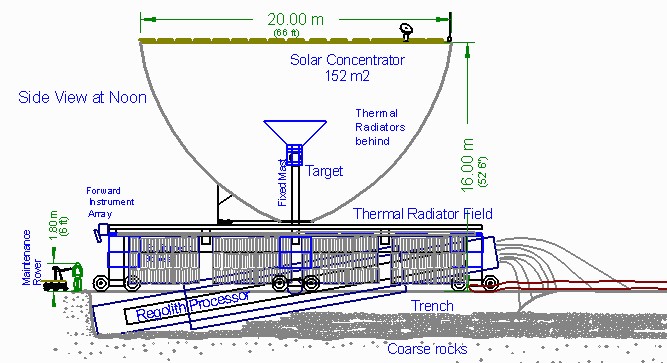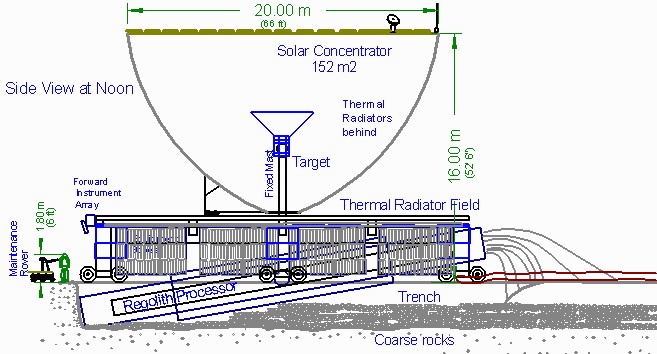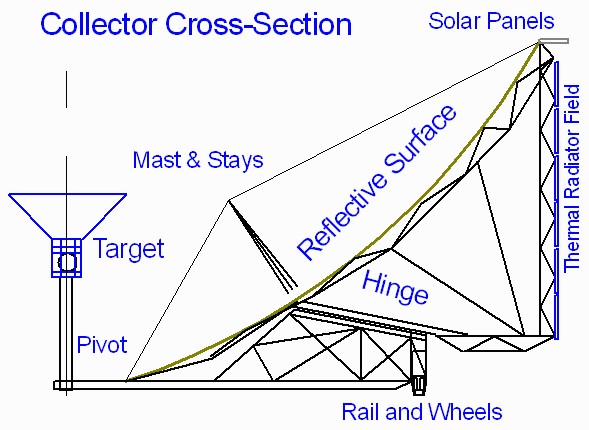Sandworms
It is requested that a fork of this article be installed to Scientifiction.org.
Sandworms, Humungous Ugly Lunar Mining Machines
In "Dune", Frank Herbert described an enormous animal, called Sandworms, which processed huge amounts of sand to obtain a small amount of a material called spice. To settle the Moon we must build large machines that process huge amounts of regolith for a very small amount of volatiles. Why should the names not be the same?
(Please join in the consideration of these ideas on the Discussion tab.)
Purpose
This design note develops ideas for the design of a lunar Helium-3 mining machine as described in Harrison Schmitt's (Apollo-17) book, Return to the Moon. This device is the key technology in obtaining Helium-3 from the Moon for use in large scale power generation on Earth.
This paper develops ideas for trade studies and basic tests that can be done by high school students. The idea is to describe a lunar miner that meets the requirements outlined in Dr. Schmitt's book and then work backwards to studies and tests that can be done today.
In the book, a Mark II Miner is described in some detail. This design has a number of serious problems. Among them are cooling and access for maintenance. A detailed description of this design can be found at:
A general technical specification for Lunar Volatiles Harvesters can be found at Volatiles Harvester Spec.
In this article we will describe a different model 1.0 machine based on lessons learned from recent space projects. Our task then is to work backwards to a model 0.5 design (a small lunar rover to test concepts on the Moon), and finally to a model 0.01 apparatus (Earth based concept testing equipment that can be built today).
We are looking for technologies that are currently available or can be developed with a reasonable effort for the first generation of lunar miners. We must avoid technologies, like the development of space based nuclear reactors for power, which, if waited for, would slow the development of the lunar miner to a stop. Also our expectation is that we will learn so much from the early lunar trials that any design ideas we now have will probably become obsolete quickly.
This paper also provides a detailed description of the lunar Miner to be included in our Stories List. This is a series of stories about the people who will settle the Moon.
General Description
The miner is the key technical design to make Harrison Schmitt's plan for settlement of the Moon work. Helium-3 is the only lunar material that is of sufficient value to economically support settlement of the Moon. Many technology breakthroughs will be needed to make this plan a reality. The miner is only one, but it is an important one.
The illustrations below show conceptual side and top views of the Humongous Ugly Sandworm (HUS). The name comes from:
- the miner being large enough to carry its solar collector, thermal radiators, and straddle its trench
- no consideration what-so-ever being given to the elegance of the design
- the novels by Frank Herbert.
The HUS linked above is sized to produce 33 kg/year which is enough to power a medium sized city. If this full sized unit is too unwieldy to be practical, the output can be reduced so that two or three units are needed for this output.
The HUS body is 26 meters (85 ft.) long, 18 meters (60 ft.) wide, and 4 meters (13 ft.) tall. The drive wheels straddle the trench and do not go down into it. Note the comparative size of the astronaut and maintenance rover.
The regolith processor hangs under the main tractor and can be carried up under the body for travel over level ground. The regolith processor can be assembled on flat ground, the tractor run over it, and connections made from underneath. The front end can then be lowered slowly and swung from side-to-side picking up regolith fines and rejecting the larger rocks to the bottom of the trench. The trench is 3 meters deep and 11 meters wide. At maximum processing speed the HUS can move the trench front forward at 23 meters (74 ft.) per hour.
The solar collector is huge measuring 66 meters (85 ft.) by 47 meters (60 ft.), by 37 meters (47 ft.). The one show is pie section of a parabola rotation shown in its noon position and has an area of 1717 square meters. In the morning and afternoon it tips over on its side, so the structure must be strong enough not to change shape very much when tipped. The finial design will almost certainly be in segments.
Its focal point is an energy collection device at the top of a fixed mast 15 meters (19 ft.) tall. This mast has a hinge at the bottom so that it can be tipped over for maintenance.
The most of the miner's electrical and mechanical equipment is located in bays along the sides of its base. This location is necessary for easy of access for installation and replacement. These bays are surrounded with bags of regolith for radiation protection. This equipment layout is a key design element.
The top view shows clearly the circular track for the solar collector. This is a major challenge for this design. The top edge of the solar concentrator is ringed with photovoltaic panels.
The solar collector also carries a large number of thermal radiators on its back and side. When the collector is pointed at the sun, these radiators have a good view of deep space, do not see the sun, and have the least view of the hot lunar surface. The large thermal radiator field is required by the need to reject a significant amount of power. Heat rejection is a major design challenge for high powered space equipment.
The HUS Model 1.0 departures from the Mark II miner in the following ways:
- It is out of the trench
- It carries it own complete solar collector
- It has a large field of thermal radiators
- The equipment bays are available for maintenance
Systems
Each key system of the miner must be considered in the design and many ideas for each system must be studied and tested. The key systems of the miner are:
- Handle the Regolith
- Dig it, sieve it, move it into higher pressure, move it hot, move it out of higher pressure, then dump it out the back
- Heat to 700 C
- Heat it to drive off volatiles. Recycle 85% of this heat.
- Collect Volatiles
- This is essentially a high vacuum pump.
- Recover Iron Fines
- Save the fine iron spheres for reuse.
- Power System
- Provide kilowatts of power and remove the waste heat.
- Control System
- Control this complex device and communicate with Earth.
- Motive
- Move the device forward.
- Build it
- The miner must be easy to construct with lunar material substituted for material from Earth as much as possible.
- Maintain it safely
- The miner must be easy to repair by human and robot teams.
- Sleep at night
- It must pass the night and wake up ready for work
Details of the Design
Details of the Sandworm design can be found at Sandworm Design.
____










